Data Management Assignment: Proposing Management Solution For Slow Fashion Pty Ltd
Question
Task:
Case Scenario
You are a Business Development Manager in a large IT Services organisation that provides data management services for various clients in Australia. Your organisation enjoys a very good repute for its services and is rated exceptionally well in the business community.
You are tasked by your supervisor, Vince Sutter, the president of the organisation, and your direct supervisor, to write a service proposal for a potential client. The potential client of your organization, Slow Fashion Pty Ltd, is a fast-growing clothing retailer who has traditionally done business via their physical stores and now has a fast-growing online business. This retailer has almost 50 stores around Australia/NZ and now gets average of 500 sales a day via their online store. Like your organisation, this retailer also enjoys a very good reputation and is ranked as one of the best bricks and mortar business in their category.
Jane Brown, CEO of Slow Fashion, is a forward-thinking business women. She wants to ensure that the company should optimise its operations and keep improving their customer service given their hybrid “clicks and mortar” business model. Given the fact that the retailer has a large number of existing customers and growing online customer base as well, Jane Brown sees an opportunity for improvement in operational performance with an increased focus on customer service. Ms Brown now wishes that the staff would focus more and more on product development, supplier management and customer service, which is the core function of the retailer. To generate better focus, she and the company’s Board of Directors would like to explore using managed services for their non-core operations. They plan to outsource the retailer’s data management function to a reputed organisation that is capable of managing their data. Ms Brown searches for a data management company and comes across your organisation. She meets Vince Sutter and asks him to submit a pre-proposal for their data management function.
Task Summary
In this data management assignment, you are required to write a 1500-word report proposing data management solutions for the organisation presented in the case scenario.
Task Instructions
1. Please read the above case scenario.
2. Write a 1500-word data management pre-proposal for the organisation.
3. The pre-proposal should not only discuss the technical but also the managerial aspects (cost, manpower, resources, etc.). Please keep in mind that you are writing a pre-proposal and not a detailed proposal.
4. Please ensure that you remain objective when writing the pre-proposal.
5. Your pre-proposal should ideally answer (but not be limited to) the following questions:
a) What would the data management strategy be
b) Which kind of data would be managed by your organization and how
c) How many staff members at your organization would manage data of this retailer; what would be the team hierarchy and what would their expertise be
d) What resources would be required from the retailer
e) What deliverables (hard and soft) would be provided to the retailer
f) What would general data management operations look like
g) How would data management policy be set and how would it be implemented
h) How would metadata be managed
i) How would data quality be managed
j) How would data management practices be audited and how would quality be assessed
k) How will user and business requirements be collected from the clients
l) Which data architectures and platforms would be used
m) How would legacy data be taken care of
n) How would risks be managed
o) What benefits would the retailer have as a result of outsourcing this service to your organisation
p) Others….
6. The questions mentioned above are written randomly, in no particular sequence. When addressing these questions in your pre-proposal, please ensure that you write in a systematic way. Make use of the web to find out what pre-proposals look like.
Answer
1.0 Introduction
This pre-proposal report on data management assignment aims to propose an efficient management solution for the Client, Slow Fashion Pty Ltd, which is a fast-growing clothing retailer all over Australia and New Zealand. Slow Fashion Pty follows a 'clicks and mortal' business model under which it operating through over 50 physical stores and a fast-growing online business which gets on an average of 500 sales per day. In this pre-proposal, an idea of service planning for Slow Fashion Pty has been provided considering the unique data management requirement of the brand.
2.0 Discussion
2.1 Kind of data managed by the organisation (b)
Our organisation provides IT services to businesses all over the country considering their unique data management requirements. The services offered by the company include management of different types of data which are:
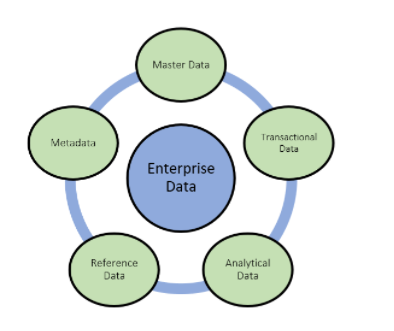
Fig-1: Types of Data
(Source:Enterprise Data Management—types of data., 2021)
• Transactional data: It is the data related to the core business activities including, production, procurement, sales and so on.
• Master data: It comprises the key information which makes up the transactional data. E.g. customer details, supplier's details, employee's details(Enterprise Data Management—types of data., 2021).
• Analytical Data: it is the aggregate and systematic compilation of transactional data which are further diced and sliced using the master data for business analysis.
• Reference data: it is a standardised subset of master data and less volatile compared to master data(Cox&Verbaan., 2018).
• Meta-data: this kind of data provides the structural information and description about the other type of data.
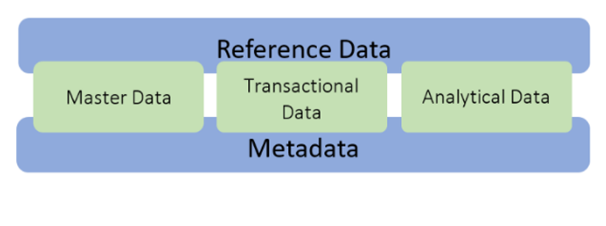
Fig-2: logistic structure of different types of data
(Source:Enterprise Data Management—types of data., 2021)
2.2 The design of a general data management operation (f)
Data management can be described as a synchronised process of ingesting; storing, organising and maintaining collected as well as created by an organisation. Effective data management is crucial to determine the organisational and market trend for making strategic decisions in the field of product development, market expansion, innovation and various other aspects of the business. A general data management operation typically comprised of six stages which are shown in the following figure:
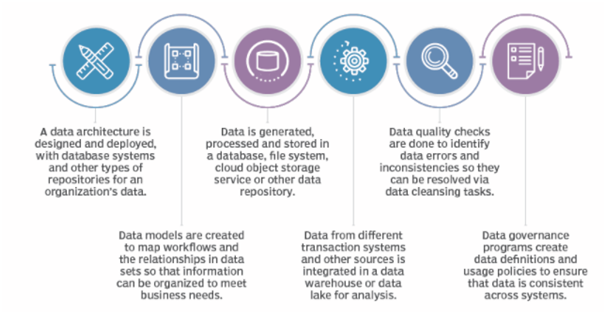
Fig-3: A general Data Management Operation
(Source: The 2 Types of Data Strategies Every Company Needs., 2021)
2.3 Proposed data management strategy
There are majorly two approaches of data management, defensive and offensive, based on the flexibility and control of its uses. The data defence approach is more about minimising downward risk giving maximum focus on ensuring compliance with regulations, identify and limit fraud using analytics and so on. On the other hand, data offence is more focused on supporting customer-focused aspects of the business functions, such a sales and marketing, product development. The trade-off between both approaches for designating an efficient data management strategy depends on the nature of business and the purpose of the business to implement a data management strategy(The 2 Types of Data Strategies Every Company Needs., 2021). The elements of data strategy are shown in the following table.
|
|
Defence |
Offence |
|
Core objectives |
ensuring data privacy, integrity, security, governance and regulatory compliance |
enhancing competitive positioning and market share |
|
Core activities |
Optimisation of extraction, standardisation, storage and access of data |
Optimisation of data analytics, transformation, enrichment and visualisation of data |
|
Orientation of data management |
Controlled |
Flexible |
|
Architecture |
Single Source of Truth (SSOT) |
Multiple Versions of Truth (MVOT) |
The purpose of the proposed data management strategy for Slow Fashion Pty is to support its 'click and mortal' business model so that the organisation use the data to enhance the growth of its online business along with bringing improvement in operational performance with an increased focus on customer service. Further, an efficient data management strategy aims to provided which enable the organisation to make effective decisions regarding product development, customer service and supplier management.
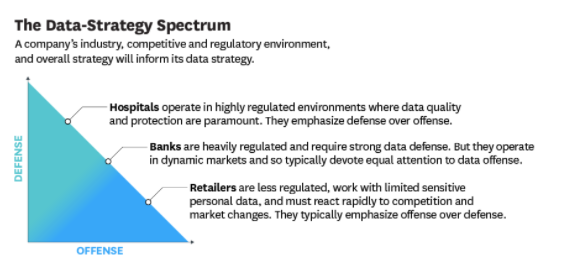
Fig-4: Data-strategy spectrum
(Source:The 2 Types of Data Strategies Every Company Needs., 2021)
Slow Fashion Pty belongs to the fashion retail industry, which is less regulated and deals with limited sensitive personal and data and is highly reactive towards the dynamics of the market. So considering the purpose of the brand and nature of the industry the offensive elements will largely be focused on the data management strategy and only the necessary elements of offensive elements will be taken into consideration.
2.4 Managerial aspect of the proposal (3)
Cost: considering the client needs and the proposed specification of the cost of the entire package of data management service will lies between AU$ 10k-15k (can be adjusted later).
Manpower: evaluating the need of the project at least 8 to 10 people will be engaged with the project
2.5 Required resources (3) (d)
• Databases
• Transactional data of physical stores
• Flat files
• Web services
• Skilled human resource
• Financial resource
• Other resources such as RSS feed
2.6 Data management team allotted for the retailed (C)
A team of 8-10 people will be prepared for the data management project of Slow Fashion Pty, and the size of the team will be increased if needed.The role and structure of the team are shown in the following figure:
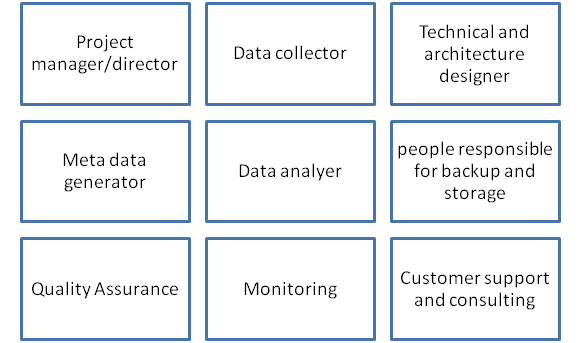
Fig-5: Data management team structure
(Source: Self-created)
2.7 Deliverables provided to the retailer (e)
Hard
• Hard copies of data files
• Hard copies of analytics of the data
Soft
• Efficient management and analysis of the data of the company
• Periodically (weekly, monthly) delivery of data trends
• Handover of all the data in a timely manner
• Ensured quality of the data
2.8 The method to set and implement the proposed data management policy (g)
In order to initiate the project plan, a data architecture will be designed considering all the aspects of the unique requirement of the client and a proper database system will be generated. For the project of Slow Fashion Pty the use of a 'rational database management system' is proposed, which is build around the SQL programming language which is best to deal with the structured transactional data(Loureiro, Miguéis and Silva., 2018).
2.9 The proposed approach to manage metadata (h)
Metadata is crucial as it enables the optimise use of the data, it ensures that the data is efficiently found, used, preserved and reused. The metadata schema, which is the overall structure of the metadata, is optimally utilised as an approach to metadata management. Besides that the following ways will be utilised to manage metadata:
• The application of system data to skywards manage the technical metadata and the alignment of the business rules and purposes with the systems
• The establishment of a connection between business metadata with technical metadata through data architecture via logical and conceptual models (Li, Xiao &Xiong., 2019).
2.10 Data quality management approach (i)
Proper data quality assessment tools will be used to ensure the quality of data. The quality of data will be managed based on the sex metrics which are:
• Accuracy:this about the degree to the data accurately reflect the trend, performance and other events
• Completeness: data is said to be complete when it fulfils the pre-defined expectations of the clients and is useful enough to make meaningful conclusions.
• Consistency:this reflects that two data values retrieved from multiple data sets must not conflict with each other
• Integrity:it is about the validation of the data which involves structural data testing to ensure the authenticity of data(Mahanti., 2018).
• Validity: the data needed to be organised in proper format and categories raging as per the business specification.
• Timeliness: the data will be provided to the clients at the time stated in the contract.
2.11 Tool used for auditing data management practices and quality assessment (j)
For auditing data management practices and quality assessment the MySQL Enterprise Audit tool is proposed to be used as the tool is highly effective in policy based auditing by offering a user-friendly interface.
2.12 The ways to collect user requirements from the client
The transactional data regarding sales, production, suppliers are collected from the client through a proper data sharing application and an automatic data collection system will be enabled through which the data regarding the online sales are directly generated. And in terms of sales in the physical stores, a contract of timely sharing of data will be made(Polyzotis et al., 2017). Besides that, through the process of automation, the data regarding market trends and other requirements will be collected.
2.13 The proposed data architecture
Data architecture can be defined as the structure of an organisation’s physical and logical data assists as well as data management resources. Considering the requirement of Slow Fashion Pty, the DAMA-DMBOK 2 data architecture framework is proposed as it offers standard definitions for the data management functions, roles, deliverables and other terminologies.
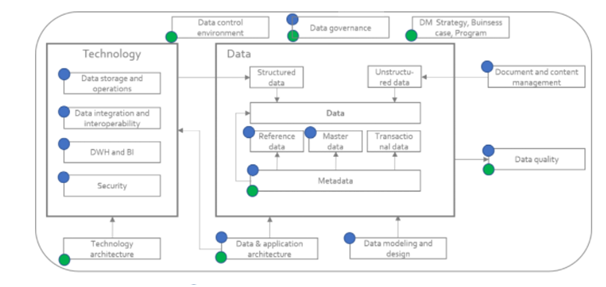
Fig-6: DAMA-DMBOK 2 data architecture framework
(Source: Polyzotis et al., 2017)
2.14 The approach to manage legacy data (m)
With respect to legacy data management, a meeting will be arrange with the client regarding the present format of the legacy data files based on the present system and privacy policy of the brand, the legacy data will be asked to handover and a contract of complete maintenance of security of such data will be make with the clients.
2.15 Risk management
In order to minimise the associated risk with the data management, all the regulatory aspects associated with data management with performed. The following best practices will be performed to ensure the minimisation of risks:
• Identification of the scope of all the identified risk factors based on the used technology and infrastructure used
• Assessment of the likelihood of occurrence and impact of the identified risk factors
• Timely evaluation of the quality of the control measures
• Assessment for risks and determination of the responses(Loureiro, Miguéisand Silva., 2018).
• Reduction of the chances of data losses by keeping reliable backups.
2.16 Benefits enjoyed by the organisation
The organisation can shift all its unnecessary hazards regarding data management and focus on its core business activities. with a complete package of data management, the organisation get all its data managed as well the trends analysed with the experts using which they can make effective strategic decisions and design effective strategies to achieve their business objectives.
3.0 Conclusion
In this pre-proposal, the unique requirements of the clients have been given special emphasis, which is crucial for any data management planning. It is initial planning which has been prepared based on the basic details provided by the clients the elements of the plan can be changed as per the need and demand of the client.
Reference List
Cox, A., &Verbaan, E. (2018). Exploring research data management. Facet Publishing. INSERThttps://lesa.on.worldcat.org/oclc/1038058072
Enterprise Data Management—types of data. (2021). Retrieved 5 October 2021, from https://medium.com/data-strategy-and-management/identifying-issues-with-enterprise-data-management-chapter-0-1cf3ec6b5757
Li, H., Xiao, F., &Xiong, N. (2019). Efficient metadata management in block-level CDP system for cyber security. IEEE Access, 7, 151569-151578.https://ieeexplore.ieee.org/iel7/6287639/8600701/08873642.pdf
Loureiro, A.L., Miguéis, V.L. and da Silva, L.F., 2018. Exploring the use of deep neural networks for sales forecasting in fashion retail. Data management assignmentDecision Support Systems, 114, pp.81-93.https://www.downloadmaghaleh.com/wp-content/uploads/edd/maghaleh/1398/13301.pdf
Mahanti, R. (2018). Data quality : dimensions, measurement, strategy, management, and governance. ASQ Quality Press. https://lesa.on.worldcat.org/oclc/1159982752
Polyzotis, N., Roy, S., Whang, S. E., &Zinkevich, M. (2017, May). Data management challenges in production machine learning. In Proceedings of the 2017 ACM International Conference on Management of Data (pp. 1723-1726).https://dl.acm.org/doi/pdf/10.1145/3035918.3054782
The 2 Types of Data Strategies Every Company Needs. (2021). Retrieved 5 October 2021, from https://hbr.org/2017/05/whats-your-data-strategy












